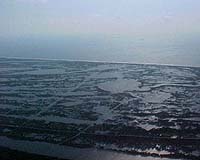| . |  |
. |
New Orleans, Louisiana (AFP) May 17, 2010 Giant plumes of oil floating deep in the Gulf of Mexico could create a new 'dead zone' of oxygen-depleted waters unfit for marine life and wreak environmental damage that will take generations to overcome, scientists warned Monday. "Normally, in a shallow spill, everything pretty much shoots up to the surface and the impacts are primarily to surface organisms like turtles, dolphins, and birds," said Paul Montagna, a marine ecologist at the Harte Research Institute for Gulf of Mexico Studies. But the oil which has been gushing out of the wreckage of the BP-leased Deepwater Horizon since April 22 is traveling up through chilly, dark waters 5,000 feet below the surface. "Under this really cold, high pressure environment the oil is getting dispersed through the water column," Montagna said in a telephone interview. "What that means is that basically life in the entire water column is now being exposed." Adding to the toxic soup are more than 580,000 gallons of chemical dispersants applied to the surface of the slick and also directly into the subsea stream of crude gushing out of a ruptured pipe. Those dispersants are being used to help keep the oil away from sensitive shorelines by breaking it up into smaller clumps, some of which will be consumed by microbes and some of which will eventually sink to the ocean floor. The problem is that those microbes end up consuming oxygen in the process and there is an enormous amount of oil that needs to be consumed, said Chris D'Elia, dean of the School of Coast & Environment at Louisiana State University. "The toxicity alone or the bod (the biological oxygen demand) problem alone are substantial issues," D'Elia told AFP. "When you start adding the two together, God only knows what's going on." The Gulf already suffers from a massive 'dead zone' which forms every spring when agricultural runoff carried out to sea by the Mississippi River causes algae to bloom and suck up the oxygen in shallower waters. Mobile marine life like fish, shrimp and dolphins usually migrate east of the dead zone, which happens to be the area most directly affected by the oil slick. "Clearly you'd expect a huge die off in the water column as well as in the (affected) sediments," said Wilma Subra, a chemist and consultant who works with the Louisiana Environmental Action Network. Another major concern is that the subsea oil and dispersants can be carried by currents in an entirely different direction that where the wind and waves send the surface slick, creating a "much larger area of impact," Subra said. BP has managed to stem the flow of oil by about 1,000 barrels a day using a mile-long tube inserted into the mouth of the ruptured pipe which is funneling the crude up to a waiting ship. BP estimates that about 5,000 barrels of oil a day are currently gushing out of the pipe, but independent experts have said that the amount could be as much as ten times higher. "Even when the leak is stopped completely, there's still going to be that large sheen, there's still going to be that large (level of) dispersant in the water column and in the sediment," Subra told AFP. "The environmental impact will go on from those sources for a very, very long time and the results of those impacts will last for generations." Researchers with the National Institute for Undersea Science and Technology discovered evidence of huge undersea plumes of oil - one reportedly 15 to 20 miles long and four or five miles wide - which were already beginning to deplete the oxygen in nearby water by as much as 30 percent. Jane Lubchenco, who heads the National Oceanic and Atmospheric Administration, cautioned that it was "premature" to conclude that the plumes were caused by the use of chemical dispersants. "As we have emphasized, dispersants are not a silver bullet," she said in a statement. "They are used to move us towards the lesser of two environmental outcomes. Until the flow of oil is stemmed, we must take every responsible action to reduce the impact of the oil."
Share This Article With Planet Earth
Related Links Our Polluted World and Cleaning It Up
 Winds, currents keep massive oil slick from shore
Winds, currents keep massive oil slick from shoreNew Orleans, Louisiana (AFP) May 17, 2010 Favorable winds and currents have kept most of the massive Gulf oil slick from reaching the fragile wetlands and sandy beaches of the US Coast for more than three weeks, experts said. But landfall is inevitable given the sheer volume of crude gushing out of the wreckage of a BP-leased rig, as is damage to marine life and the subsea ecosystem. "It's going to be bad," said biologist Dennis ... read more |
|
| The content herein, unless otherwise known to be public domain, are Copyright 1995-2010 - SpaceDaily. AFP and UPI Wire Stories are copyright Agence France-Presse and United Press International. ESA Portal Reports are copyright European Space Agency. All NASA sourced material is public domain. Additional copyrights may apply in whole or part to other bona fide parties. Advertising does not imply endorsement,agreement or approval of any opinions, statements or information provided by SpaceDaily on any Web page published or hosted by SpaceDaily. Privacy Statement |